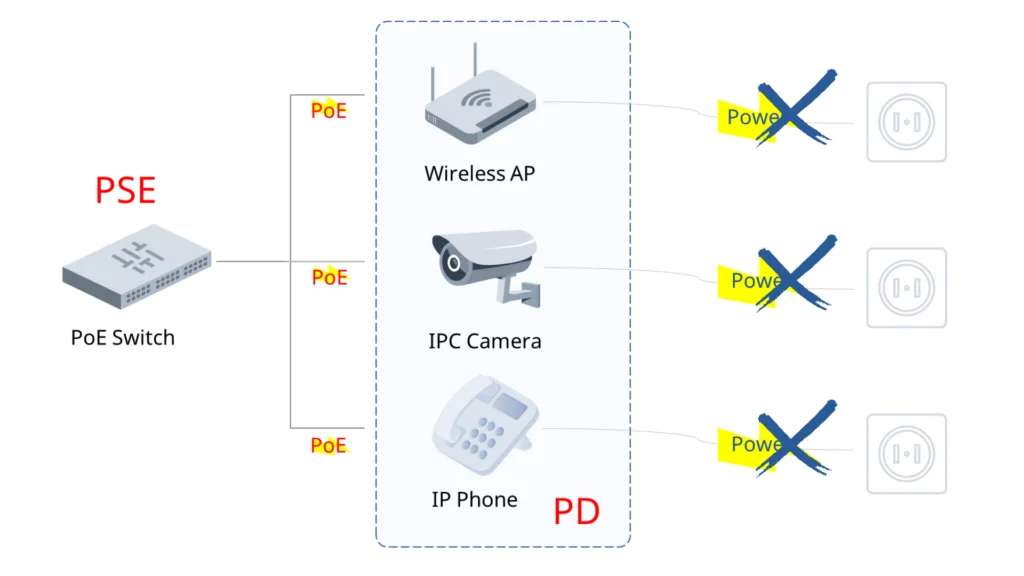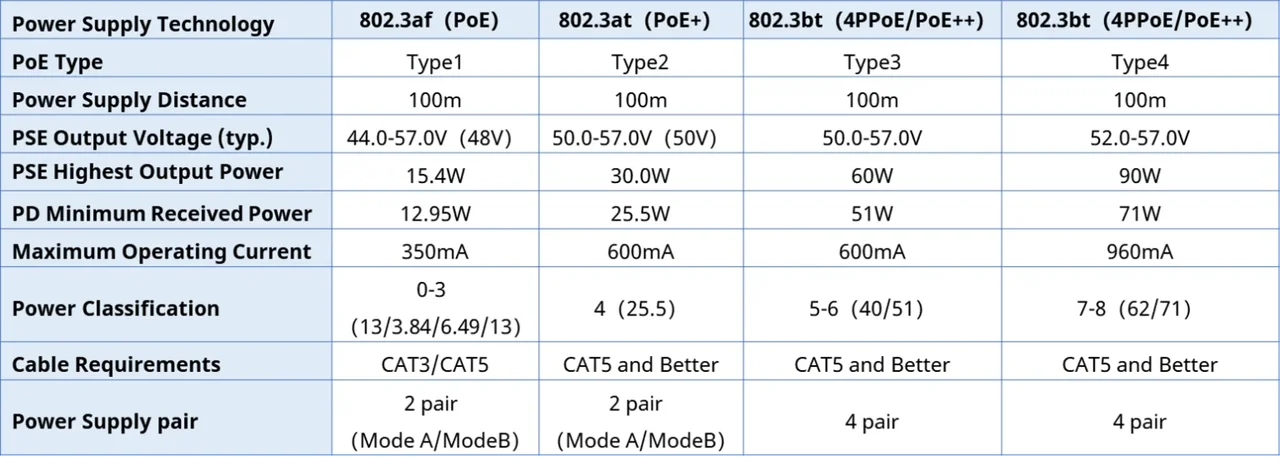What is a PoE Switch and How to choose the right one for you?
What is Power over Ethernet (PoE)?
PoE is a technology that can transmit power and data to devices through twisted pair cables in Ethernet.
What devices can you connect to a PoE switch?
A PoE switch comes equipped with numerous Ethernet ports that are capable of connecting various devices, including VoIP phones, wireless access points, and IP cameras.
How does PoE work?
The PoE power supply system consists of two primary equipment roles:
- Power-sourcing equipment (PSE): Typically a PoE switch, this device supplies power to the powered devices through Ethernet. It provides functions such as detection, analysis, and intelligent power management.
- Powered devices (PD): These devices include wireless APs, portable device chargers, card readers, cameras, and other powered devices. Depending on whether they comply with IEEE standards, PD can be categorized as standard or non-standard.

When should I use a PoE switch?
The increasing prevalence of the Internet of Things and smart cities has led to a surge in the number of mobile terminals, including wireless APs, cameras, and IP phones. These devices can be deployed in various locations, making it challenging to provide them with power through traditional wiring methods, which often results in high costs.
Moreover, in large-scale LAN applications, administrators often have to manage multiple terminal devices in the same time. These devices require a unified power supply and management. However, due to the limitations of power supply locations, this can create significant inconvenience in power supply management. PoE technology effectively resolves this problem.
Typical scenarios for using PoE switches:
- VoIP phones: If your organization uses a VoIP (Voice over IP) phone system, these phones need to transmit data and power at the same time, so using a PoE switch can simplify wiring and reduce the number of devices.
- Network cameras: When installing IP cameras, you can provide power and data connections to the camera through a single Ethernet cable without the need for additional power cables.
- Wireless access points: PoE switches can be used to provide power to wireless access points (APs). This way, you can install the AP in the best location without being restricted by the location of the power outlet.
- Industrial automation equipment: In industrial environments, use PoE switches to power automation equipment, sensors, and controllers.
- Digital signage and lighting: PoE switches can provide power for devices such as digital signage or LED lighting used in offices, stores, or other places.

PoE Standards Introduction
In order to standardize the development of PoE power supply technology, and to solve the compatibility problem between power supply and powered devices from different manufacturers, IEEE Standards Committee has released three PoE standards: from 802.3af in 2003 to 802.3at in 2009, and then to the latest 802.3bt in 2018, the new standard is backward compatible.

IEEE 802.3af
IEEE 802.3af, also known as standard PoE, has a supply voltage of 44-57V and a supply current of 10-350mA. It specifies that PSE devices need to provide up to 15.4W of DC power on each port. However, some power is lost on the Ethernet cable in actual transmission. Thus, only 12.95W is available to the powered device. It can support VoIP phones, APs, etc.
IEEE 802.3at
In October 2009, in order to meet the needs of high-power terminals, the IEEE 802.3at standard was born. On the basis of being compatible with the 802.3af standard, the IEEE 802.3at standard provides up to 30W of power to meet new needs.Its supply voltage of PoE+ ranges from 50V to 57V and the supply current is about10-600mA. Due to power loss, the guaranteed minimum output power on each port is 25W. This type can support devices that require more power like tablets, alarm systems, etc.
IEEE 802.3bt
In September 2018, the IEEE Standards Committee released the IEEE 802.3bt standard to further improve PoE power .It further enhances the power supply capability, with Type 3 providing up to 51 W power supply and Type 4 providing up to 71.3W power supply. Also included support for 2.5GBASE-T, 5GBASE-T, and 10GBASE-T, expanding the use of applications such as high-performance wireless access points and surveillance cameras and other applications.
Generally, IEEE 802.3af standard is called PoE power supply, the IEEE 802.3at standard is called PoE+ power supply, and the IEEE 802.3bt standard is called PoE++ power supply, also known as 4PPoE. The parameters corresponding to the three power supply technologies are shown in the figure below.

Asterfusion Network Switches Comply with Various PoE Standards
What are the benefits of using a PoE switch?
Although PoE power supply cannot improve the quality and speed of the network, it greatly expands the deployment scenarios of Internet access devices. The PoE function also brings many other advantages, including:
● Cost reduction
Power is provided directly through the network cable, which significantly reduces the number of power sockets required for installing network devices and the resulting power wiring, which can reduce access costs and deployment costs.
● Flexibility
Without being connected to a power socket, devices such as surveillance cameras, wireless access points, and IP network phones can be placed in any ideal location, and are easy to move, which improves deployment flexibility. At the same time, the powered device can be remotely managed by controlling the PoE power supply device to perform operations such as power off and restart, which improves management flexibility.
● Security
Using standard-compliant PoE power supply can intelligently protect network devices from overload and insufficient power supply, and naturally avoid the potential risks caused by incorrect power supply installation.
● Ease of use
The relevant standards for PoE power supply are backward compatible, and standard-compliant power supply and powered devices can negotiate parameters on their own, providing a nearly “plug and play” experience.
● Reliability
The PoE power supply end can perform power redundancy backup through an uninterruptible power supply (UPS), ensuring continuous operation even during a main power failure.
Benefits of SONiC-base Layer 3 POE++ switch
PoE++ can provide up to 90 watts of power. It can meet the network requirements of industrial automation, data centers and other environments because it can achieve more efficient power transmission and reduce power loss, and supports power priority (power can be allocated to key devices first) and device discovery (allowing PSE to detect and verify connected devices). In these complex environments, three-layer switches have many advantages such as fast speed and good performance, and are highly favored by people. SONiC, as a popular open source network operating system, is also widely used in large-scale user scenarios due to its scalability and ease of use.
There are limited manufacturers on the market that can provide three-layer PoE++ switches, and even fewer manufacturers that can adapt to SONiC. Asterfusion’s self-developed 3-layer POE++ switches have excellent performance.
These open network switches are preloaded with a feature-rich SONiC NOS ( AsterNOS) which is a container-based application deployment . It makes the switch easy to expand new functionalities even by users. It supports wire-speed Layer 2 switching and Layer 3 routing with MC-LAG feature, comprehensive QoS, advanced security and complete network management .Asterfusion PoE/PoE+ /POE++ switches can power any 802.3af or 802.3at 802.3bt device of the market, enable them flexible and secure.
Asterfusion now has 8 port Gigabit /16 port Gigabit /24 port Gigabit /48 port Gigbit PoE /PoE+/POE++ switches that follow with the PoE standard for greater security and better functionality.
The Following Table lists Asterfusion 24/48 Ports Gigabit PoE/PoE+/POE++ Switches.
| PoE Standard | Asterfusion PoE Switch Model | Port | Switch Capacity | Power Budget | PSU | Fans |
| 802.3at | CX102S-8GT-M-SWP | 8x1GBase-T, 2x10Gb SFP+ ports | 28Gbps | 150W | 1 | 2 |
| 802.3at/bt | CX102S-16GT-M-SWP | 16x1GBase-T,2x10Gb SFP+ ports | 36Gbps | 150W | 1 | 2 |
| 802.3at/bt | CX102S-16GT-DPU-M-SWP | 16x1GBase-T, 2x10Gb SFP+ ports | 36Gbps | 150W | 1 | 2 |
| 802.3at/bt | CX204Y-24GT-M-SWP2 | 24x1GBase-T,4x25Gb/10Gb SFP28 ports | 124Gbps | 370W | 1 | 3 |
| 802.3at/bt | CX204Y-48GT-M-SWP4 | 48 x 1G base-T , 4 x 25GE SFP28 ports | 148Gbps | 740W | 1 | 3 |
| 802.3at/bt | CX206Y-48GT-M-HWP4 | 48x1G BASE-T ,6x25Gb/10G SFP28 ports | 198Gbps | 740W | 2 | 3 |
| 802.3at/bt | CX206Y-48GT-M-HWP8 | 48x1G BASE-T ,6x25Gb/10G SFP28 ports | 198Gbps | 1440W | 2 | 3 |
How to choose the right PoE switch for your needs?
There are several factors you should consider when choosing the number of PoE ports for your push button. These include the number of current and future devices, scalability, power budget, and network architecture. By evaluating these factors, you can choose a PoE switch that will perfectly match your network needs.
评论
发表评论